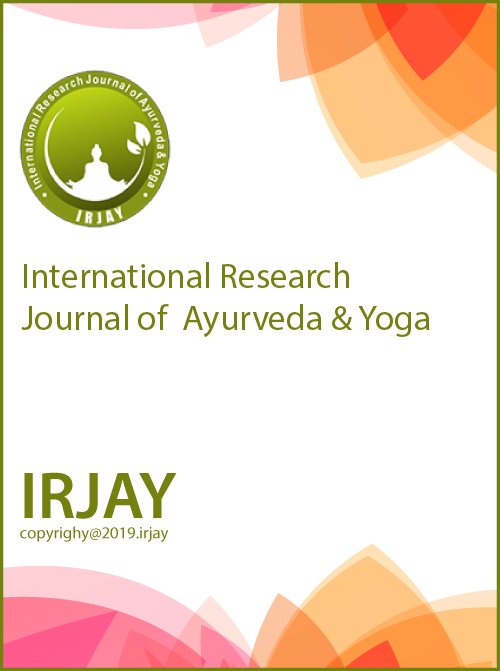The Role of Ahara in Maintaining Tridosha Functions and Swasthavritta Practices
DOI:
https://doi.org/10.48165/IRJAY.2025.80709Keywords:
Agni, Ahara, Ayurveda Dietetics, Dinacharya, Preventive Health, Ritucharya, Swasthavritta, TridoshaAbstract
In Ayurveda, diet, referred to as Ahara, is considered one of the three essential pillars of life, known as Trayopastambha. It plays a crucial role in maintaining health and preventing illness. Ancient Ayurvedic texts highlight the importance of diet in achieving the functional balance of the Tridoshas–Vata, Pitta, and Kapha–which are responsible for all physiological and psychological processes in the body. An imbalance among these doshas can result in disease, while their proper alignment promotes health and vitality. This review examines the diverse functions of Ahara in sustaining doshic equilibrium and supporting Swasthavritta, the Ayurvedic science focused on health maintenance and disease prevention. It discusses classical concepts such as Ahara Vidhi Vidhana (dietary guidelines), Agni (digestive fire), Viruddha Ahara (incompatible food pairings), as well as the dietary adjustments recommended in response to seasonal changes (Ritucharya) and daily routines (Dinacharya). In addition, this review incorporates modern scientific perspectives, drawing connections between Ayurvedic dietary principles and contemporary ideas such as personalized nutrition, circadian eating regimens, and gut microbiome health. By linking traditional Ayurvedic knowledge with modern nutrition science, the paper emphasizes the importance of individualized, mindful, and context-specific dietary practices in fostering doshic balance, enhancing digestion, and promoting long term wellness. The conclusions suggest that integrating Ayurvedic dietary principles into current preventive health strategies may provide a sustainable and comprehensive approach to overall health and well-being.Downloads
References
Yewale DS, Yewale DP. Importance of ahara in today’s life with special reference to ayurveda. Int J Life Sci Pharma Res. 2023;13:L205–10.
Kapadia M, Dagar C. Understanding self and well-being based on ayurveda: Implications for Indian management. In: Indigenous Indian Management: Conceptualization, Practical Applications and Pedagogical Initiatives. Cham: Springer International Publishing; 2022. p. 157–97.
Kalavade VA, Prakash Mane D, Ghate U. A clinical observational study on prakriti analysis and its application in ayurveda. J Pharm Negat Results. 2023;14:2215–22.
Pattnaik MK. Combining swasthavṛtta and yoga in the management of metabolic syndromes. J Swasthavritta Yoga. 2025;2:1–9.
Thottapillil A, Kouser S, Kukkupuni SK, Vishnuprasad CN. An ‘ayurveda-biology’ platform for integrative diabetes management. J Ethnopharmacol. 2021;268:113575.
Sharma T, Meghwal CR, Prajapat M, Sharma AK. Conceptual study of vata dosha w.s.r. to nervous system. J Ayurveda Integrated Med Sci. 2024;9(2):134–40.
Pareek P, Chhimpa R, Sharma RK, Sharma DC. A review of the physiological function of pachakpitta and its correlation with contemporary science. J Ayurveda Integrated Med Sci. 2023;8(7):110–2.
Swasthik, Patil A. Investigating the role of ahara (diet) in the etiopathogenesis of amavata: An ayurvedic perspective. Metall Mater Eng. 2025;31:117–29.
Chauhan S. The influential role of kapha dosha in supporting the immune system: A comprehensive exploration. World J Pharm Res. 2024;13:11–6.
Ojha PP. Role of vata dosha in digestion. Int J Med Sci. 2023.
Raval S, Parmar N, Vadhel M, Mouri K. Agni’s ayurvedic philosophy: Insights from vedic to ayurvedic texts. Interdiscip J Yagya Res. 2023;6(1):18–21.
Patil S, Palnitkar M, Jain SS. Understanding and emphasizing the concepts of swasthavritta to combat sthaulya w.s.r. to obesity. J Ayurveda Integrated Med Sci. 2025;10(2):160–4.
Vitkar AS, Dhimdhime RS. Concept of viruddha ahara and its relevance to present era. World J Pharm Res. 2024;13:1921–30.
Verma SK, Pandey M, Sharma A, Singh D. Exploring ayurveda: Principles and their application in modern medicine. Bull Natl Res Centre. 2024;48(1):77.

